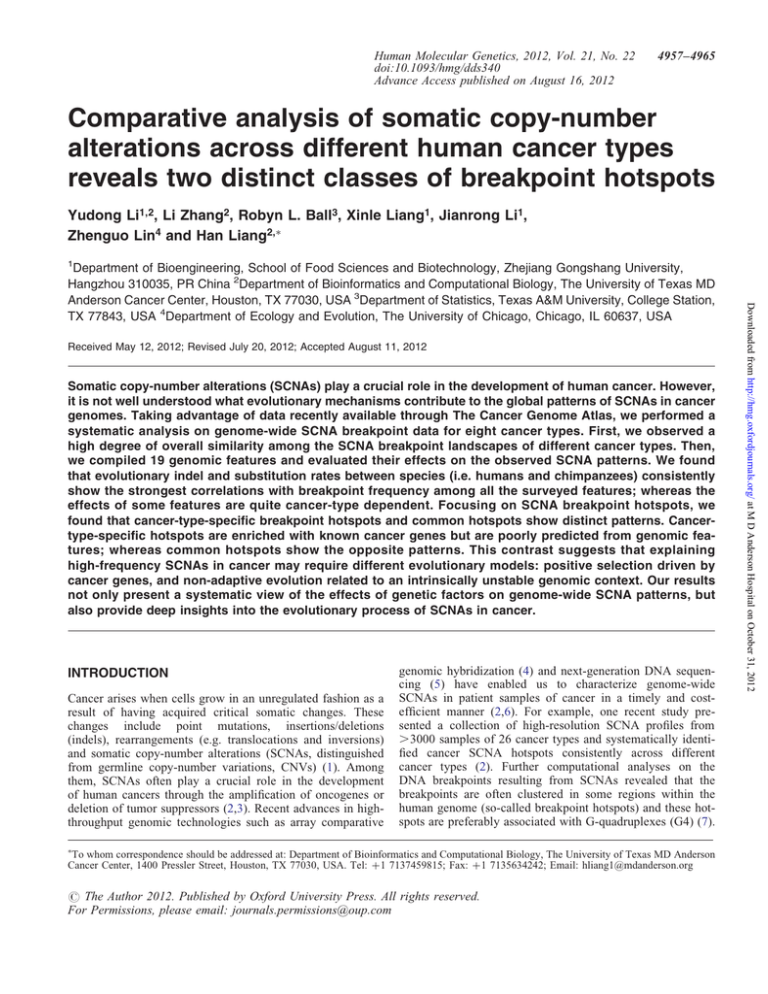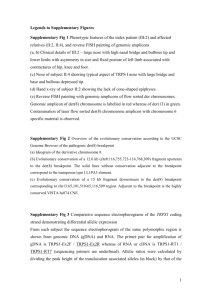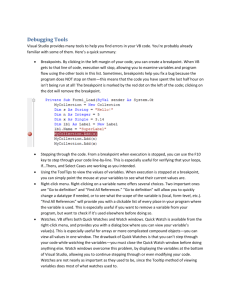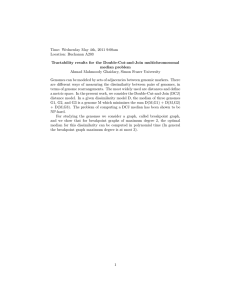
Human Molecular Genetics, 2012, Vol. 21, No. 22
doi:10.1093/hmg/dds340
Advance Access published on August 16, 2012
4957–4965
Comparative analysis of somatic copy-number
alterations across different human cancer types
reveals two distinct classes of breakpoint hotspots
Yudong Li1,2, Li Zhang2, Robyn L. Ball3, Xinle Liang1, Jianrong Li1,
Zhenguo Lin4 and Han Liang2,∗
1
Received May 12, 2012; Revised July 20, 2012; Accepted August 11, 2012
Somatic copy-number alterations (SCNAs) play a crucial role in the development of human cancer. However,
it is not well understood what evolutionary mechanisms contribute to the global patterns of SCNAs in cancer
genomes. Taking advantage of data recently available through The Cancer Genome Atlas, we performed a
systematic analysis on genome-wide SCNA breakpoint data for eight cancer types. First, we observed a
high degree of overall similarity among the SCNA breakpoint landscapes of different cancer types. Then,
we compiled 19 genomic features and evaluated their effects on the observed SCNA patterns. We found
that evolutionary indel and substitution rates between species (i.e. humans and chimpanzees) consistently
show the strongest correlations with breakpoint frequency among all the surveyed features; whereas the
effects of some features are quite cancer-type dependent. Focusing on SCNA breakpoint hotspots, we
found that cancer-type-specific breakpoint hotspots and common hotspots show distinct patterns. Cancertype-specific hotspots are enriched with known cancer genes but are poorly predicted from genomic features; whereas common hotspots show the opposite patterns. This contrast suggests that explaining
high-frequency SCNAs in cancer may require different evolutionary models: positive selection driven by
cancer genes, and non-adaptive evolution related to an intrinsically unstable genomic context. Our results
not only present a systematic view of the effects of genetic factors on genome-wide SCNA patterns, but
also provide deep insights into the evolutionary process of SCNAs in cancer.
INTRODUCTION
Cancer arises when cells grow in an unregulated fashion as a
result of having acquired critical somatic changes. These
changes include point mutations, insertions/deletions
(indels), rearrangements (e.g. translocations and inversions)
and somatic copy-number alterations (SCNAs, distinguished
from germline copy-number variations, CNVs) (1). Among
them, SCNAs often play a crucial role in the development
of human cancers through the amplification of oncogenes or
deletion of tumor suppressors (2,3). Recent advances in highthroughput genomic technologies such as array comparative
genomic hybridization (4) and next-generation DNA sequencing (5) have enabled us to characterize genome-wide
SCNAs in patient samples of cancer in a timely and costefficient manner (2,6). For example, one recent study presented a collection of high-resolution SCNA profiles from
.3000 samples of 26 cancer types and systematically identified cancer SCNA hotspots consistently across different
cancer types (2). Further computational analyses on the
DNA breakpoints resulting from SCNAs revealed that the
breakpoints are often clustered in some regions within the
human genome (so-called breakpoint hotspots) and these hotspots are preferably associated with G-quadruplexes (G4) (7).
∗
To whom correspondence should be addressed at: Department of Bioinformatics and Computational Biology, The University of Texas MD Anderson
Cancer Center, 1400 Pressler Street, Houston, TX 77030, USA. Tel: +1 7137459815; Fax: +1 7135634242; Email: hliang1@mdanderson.org
# The Author 2012. Published by Oxford University Press. All rights reserved.
For Permissions, please email: journals.permissions@oup.com
Downloaded from http://hmg.oxfordjournals.org/ at M D Anderson Hospital on October 31, 2012
Department of Bioengineering, School of Food Sciences and Biotechnology, Zhejiang Gongshang University,
Hangzhou 310035, PR China 2Department of Bioinformatics and Computational Biology, The University of Texas MD
Anderson Cancer Center, Houston, TX 77030, USA 3Department of Statistics, Texas A&M University, College Station,
TX 77843, USA 4Department of Ecology and Evolution, The University of Chicago, Chicago, IL 60637, USA
4958
Human Molecular Genetics, 2012, Vol. 21, No. 22
RESULTS
The overall similarity of SCNA breakpoint distributions
across different types of cancer
TCGA employs several platforms to characterize genomewide SCNAs, such as the Affymetrix SNP6.0 array
(AffySNP6), Agilent 244K array and Illumine 1MDUO
array (11). For this study, we focused on SCNA data generated
from the AffySNP6 platform, which contains more than 1.8
million probes for detecting CNVs. We chose the AffySNP6
array because it offers (i) one of the highest probe densities,
and (ii) large sample sizes for several different types of
cancer. For comparative purposes, we chose eight types of
cancer with the largest sample sizes (Table 1), each with at
least 150 tumor samples (with paired normal tissue specimens
from the same individual). For each cancer type, we first filtered the outlier samples, those with extremely large
numbers of segments. Then, for each sample, we identified
confident SCNA segments by considering the position,
length and amplitude of change in normalized copy-number
data (see details in Materials and Methods).
Table 1 shows the statistical summary of SCNA data used in
our study. On average, we identified 80 SCNAs (including
both gain and loss) per sample, which is comparable to that
observed in the literature (2). Among different cancer types,
ovarian cancer has the highest segment number (125 per
sample), consistent with the notion that ovarian cancer is a
disease driven by SCNAs (11,12). To characterize the
genome-wide SCNA patterns, we divided the human
genome into 1 Mb non-overlapping blocks and calculated
the number of SCNA breakpoints within each block, as in
De and Michor (7). In order to validate the SCNA breakpoint
data we obtained, we further examined 246 TCGA samples of
ovarian cancer profiled with both AffySNP6 6.0 and Agilent
1M platforms. Using the same data-processing method, we
found the breakpoint frequency for 1 Mb blocks obtained
from these two platforms to be highly correlated (Rs ¼ 0.8,
P , 2.2 × 10216). This result supports the robustness of our
SCNA breakpoint data.
As shown in Figure 1, the distributions of SCNA breakpoint
frequencies across different types of cancer are highly similar,
and there are many breakpoint peaks shared across different
types of cancer. Such a similarity also holds true when the
breakpoint distributions were calculated separately based on
the amplification and deletion SCNAs (Supplementary Material, Table S1). On average, Spearman’s rank correlation coefficient of the genome-wide breakpoint distributions between
pair-wise cancer types is 0.5, ranging from 0.32 to 0.64 (Supplementary Material, Fig. S1). At the chromosomal level,
chromosomes 9 and 22 appear to show higher similarities
than the others (Supplementary Material, Fig. S2). Each
cancer type is also characterized by specific breakpoint
peaks (red peaks in Fig. 1); we will investigate them in
greater detail in subsequent sections.
The effect of various genomic features on SCNA
breakpoint occurrence
To investigate how various genetic factors potentially affect
the genome-wide SCNA breakpoint patterns, we compiled a
comprehensive list of 19 genomic features for each 1 Mb
block (Table 2). These features can be generally classified
into four groups: (i) sequence features, (ii) DNA secondary
structure motifs, (iii) evolutionary features, and (iv) functional
features. Only some of these features have been examined by
previous studies for their effects on SCNA breakpoints (7,9).
Figure 2A shows the correlation coefficients between each
feature and the breakpoint frequency in different types of
cancer (Supplementary Material, Fig. S3 shows the distribution of these genomic features and the breakpoint frequency
along the human genome). Across different features, we
observed that two lung cancer types are clustered together
and endometrial cancer is clustered with ovarian cancer,
which is consistent with a common organ of origin. Across
different cancer types, we found that some features, such as
the indel rate between humans and chimpanzees or conserved
elements, show consistently positive or negative correlations
with the breakpoint frequency across the cancer types. In contrast, the correlations of the other features strongly depend on
the cancer type. These results suggest that the effects of
genetic factors on SCNA breakpoint occurrence are more
complicated than previously appreciated (7,9). Furthermore,
when breakpoints resulting from amplifications and deletions
Downloaded from http://hmg.oxfordjournals.org/ at M D Anderson Hospital on October 31, 2012
Moreover, DNA three-dimensional structures (8) and DNA
replication timing (9) have been suggested as the key
genetic factors predicting the genome-wide SCNA patterns
observed. While these efforts greatly advance our view on
the mechanistic basis of SCNA occurrence, it remains not
well understood what evolutionary mechanisms contribute to
the global patterns of SCNAs in cancer genomes.
Previous SCNA genomic analyses have focused primarily
on the data sets of a single cancer type or pooled data sets
from different cancer types. Although these studies elucidate
some important general trends, in-depth comparative analyses
on SCNA data of different cancer types are crucial for understanding the evolutionary mechanisms underlying SCNA occurrence and identifying cancer-type-specific characteristics.
The Cancer Genome Atlas (TCGA) project (10,11) is a valuable resource for this purpose, providing an unprecedented
collection of patient samples that have been characterized
for each cancer type in multiple dimensions using consistent
platforms.
In this study, we performed a comparative analysis on
SCNAs across eight different types of human cancer using
TCGA data. We first demonstrated that the overall SCNA
breakpoint landscapes among different types of cancer show
high similarities; and then we evaluated the effects of
various genomic features on the genome-wide SCNA patterns.
Importantly, we found that cancer-type-specific SCNA breakpoint hotspots and common hotspots show distinct patterns:
cancer-type-specific hotspots are enriched with known
cancer genes; whereas common hotspots do not show such enrichment but can be relatively well predicted from genomic
context. Our results not only present a systematic view of
the genome-wide SCNA breakpoint patterns in human
cancer, but also provide deep insights into the evolutionary
mechanisms underlying SCNA breakpoint hotspots.
Human Molecular Genetics, 2012, Vol. 21, No. 22
Table 1. Summary of TCGA SCNA data analyzed
Sample
#a
SCNA breakpoint #
(amplification/
deletion)
Breakpoint #
per sample
Breast invasive carcinoma
(BRCA)
Glioblastoma multiforme
(GBM)
Ovarian serous
cystadenocarcinoma
(OV)
Kidney renal clear cell
carcinoma (KIRC)
Colon adenocarcinoma
(COAD)
Uterine corpus
endometrioid
carcinoma (UCEC)
Lung squamous cell
carcinoma (LUSC)
Lung adenocarcinoma
(LUAD)
667
121 780 (60 758/
61 022)
64 820 (32 496/
32 324)
125 595 (622 601/
62 994)
182
48 907 (24 140/
24 020)
55 107 (27 577/
27 530)
38 673 (19 334/
19 339)
106
32 271 (16 116/
16 155)
23 161 (11 591/
11 570)
172
441
500
459
392
272
187
163
146
251
140
142
142
a
Excluding hyper-segmented outlier.
were considered separately, the observed correlations between
genomic features and breakpoint frequencies are quite similar
(Supplementary Material, Table S2). In addition, the observed
correlations were unlikely to be affected by the probe distribution of AffySNP6 in the human genome (details in Materials
and Methods; Supplementary Material, Fig. S4). However,
the correlation pattern was quite different based on those filtered outlier samples (Supplementary Material, Fig. S5).
Next, we examined to what extent the observed genomewide pattern of breakpoints could be explained by these
genomic features. Since the breakpoint distributions of different cancers in the human genome are quite similar, we performed a multivariable analysis on the pooled breakpoint
data. Through a stepwise forward regression on the transformed breakpoint data, the indel rate shows the best predictive power, and an integrated model using the top four selected
features (indel rate + exon + substitution rate + SINE) can
collectively explain nearly 14% of the variation in the test
data (Fig. 2B, Supplementary Material, Fig. S6), indicating
that the intrinsic properties of the local genomic context
play a considerable role in affecting SCNA occurrence. We
also performed similar analyses for each cancer type (adjusted
R 2 ranges from 0.068 to 0.167), and found that the substitution
rate, exon density and indel rate were among the most frequently selected features across different types of cancer (Supplementary Material, Table S3).
Enrichment of known cancer genes in cancer-type-specific
breakpoint hotspots
As shown in Figure 1, although different types of cancer have
many common breakpoint peaks, each type of cancer also has
its specific hotspots. To rigorously identify SCNA breakpoint
hotspots, we generated a background breakpoint frequency
distribution for each type of cancer, and identified the blocks
with significantly enriched breakpoints as hotspots (see
details in Materials and Methods). We obtained a total of
471 breakpoint hotspots across the eight cancer types with a
mean of 240 per cancer type (ranging from 211 to 267)
(Supplementary Material, Table S4). In a comparison with a
prior study, we found that .70% of the SCNA hotspots previously identified (2) overlapped with the breakpoint hotspots
we identified in this study. To test the relationship between
these hotspots and cancer genes, we obtained a set of 468
cancer genes defined by Futreal et al. (13) that have been
widely used as a set of known cancer genes. We found that
the hotspots we identified are significantly enriched with
known cancer genes (Supplementary Material, Fig. S7).
Next, we examined how frequently the breakpoint hotspots
were detected in the eight types of cancer and found that they
exhibited a clear bimodal distribution (Fig. 3A). We defined
the hotspots found in only one type of cancer as
cancer-type-specific hotspots (highlighted in red in Fig. 1)
and defined those detected in all eight cancers as common hotspots. To understand how known cancer genes are related to
these two classes of breakpoint hotspots, we examined the
overlap between these hotspot blocks and known cancer
genes. Interestingly, we found that the number of cancer
genes that overlapped with a cancer-type-specific hotspot
was significantly higher than what we would expect by
random chance (Fig. 3A, P , 0.001, Supplementary Material,
Table S5), but that the number of cancer genes that overlapped
with a common hotspot was lower and not statistically different
(Fig. 3B, P , 0.11). Indeed, the ratio of cancer-type-specific
hotspots that overlapped with a known cancer gene was significantly higher than that for the common hotspots (30.6 versus
12%, respectively, Fisher’s exact test, P , 1.5 × 1025). Consistently, the distance from a type-specific hotspot to its
nearest cancer gene was much smaller than that distance for
a common breakpoint hotspot (2799 versus 5288 kb, Wilcoxon
rank test, P , 1.5 × 1026). This same observation was made
when centromere and telemere-related blocks were excluded
from our analysis (Supplementary Material, Fig. S8a and b).
Moreover, we obtained similar results when using more
flexible definitions (definition of a cancer-type-specific hotspot
as that detected in one or two cancer types; a common
hotspot, detected in 7 or 8 cancer types) (Supplementary Material, Fig. S8c and d). Taken together, our results indicate that
these two classes of hotspots indeed show very different
patterns in terms of their co-localization with cancer genes.
Predictability of common cancer breakpoint hotspots from
genomic features
To investigate how genomic context can affect the distribution
of breakpoint hotspots in the human genome, we compared the
predictability of cancer-type-specific hotspots and common
hotspots using a machine learning approach. We built a
random forest classifier to distinguish 150 common hotspots
(or 183 cancer-type-specific hotspots) from 2409 non-hotspot
blocks using 19 genomic features. Figure 4A shows the receiver operating characteristic (ROC) curves for the predictive
models (10-fold cross-validation). The area under the ROC
curve (AUC) is a standard measure for the predictive power
Downloaded from http://hmg.oxfordjournals.org/ at M D Anderson Hospital on October 31, 2012
Cancer type
4959
4960
Human Molecular Genetics, 2012, Vol. 21, No. 22
Downloaded from http://hmg.oxfordjournals.org/ at M D Anderson Hospital on October 31, 2012
Figure 1. The distribution of SCNA breakpoint frequencies in eight types of human cancer. Cancer-type-specific breakpoint peaks (hotspots) are highlighted in
red.
of different classifiers (the diagonal line in the ROC curve has
an AUC value of 0.5, representing the power of a random
guess). The AUC score for common hotspots is 0.754,
whereas that for cancer-type-specific hotspots is only 0.592,
indicating a much higher predictability for common hotspots.
Furthermore, we obtained similar results when the two types
of breakpoint hotspots were defined in a relaxed way (Supplementary Material, Fig. S9). Figure 4B shows a mean decrease
in accuracy when a feature is permuted, which is commonly
used to measure a feature’s relative importance (14). Interestingly, the important features determined in the classifier for
common hotspots, such as exon density, substitution rate and
indel rate, were consistent with the results of the above multivariate regression analysis. These results suggest that common
breakpoint hotspots strongly depend on the local genomic
context.
Human Molecular Genetics, 2012, Vol. 21, No. 22
Table 2. Genomic features investigated in this study
Features
Recombination
rate
Functional features
Fragile sites
Exon densityb
miRNA
Replication time
Sources
GC nucleotide
Coverage
Coverage
Coverage
‘GC percent’ tracka
‘CpG island’ track
‘RepeatMasker’ track
‘RepeatMasker’ track
Coverage
Coverage
‘Simple Repeat’ track
‘Microsatellite’ track
Coverage
Coverage
Coverage
Coverage
Coverage
Quadruplex.org
Non-B DB
Non-B DB
Non-B DB
Non-B DB
Coverage
Centimorgan (cM)
‘17-way most conserved’
track
Human–Chimp alignment
Human–Chimp– Macaque
alignment
Myers et al. (23)
Yes/no
Coverage
Count
Mean
‘Gene’ database of NCBI
‘UCSC genes’ track
miRbase database
Chen et al. (15)
Percentage
Percentage
LINE, long-interspersed repetitive elements; SINE, short-interspersed
repetitive element; PG4, Potential guanine-quadruplex sequences.
a
The track data in this table were downloaded from the UCSC Genome
Browser, based on the human reference genome hg18.
b
Exon base positions overlapping with multiple exons were counted once.
DISCUSSION
Taking advantage of recently available TCGA SCNA data, we
systematically analyzed the effect of 19 genomic features on
the SCNA breakpoint distribution in different cancer types.
To the best of our knowledge, this is the most comprehensive
analysis based on the largest SCNA data set of human cancer
so far. Recent studies on pooled SCNA breakpoint data have
shown that some genomic features we surveyed, such as
repeat elements and G4 motifs, are associated with genomewide SCNA patterns (7,9), but it remains unclear whether
the same trend holds for every cancer type. We found that
the correlations of these features depend on the cancer type,
suggesting that the effect of these genetic factors on SCNA occurrence is more complicated than previously appreciated (7).
The replication time data we used were from HeLa cells (15).
It is known that replication time substantially varies among
different tissues (16), which might contribute to the observed
type-dependent correlations. Surprisingly, there is weak or no
correlation between the breakpoint frequency and the presence
of fragile sites in our analysis. This may be due to the low
resolution of fragile-site data: fragile sites in our data set are
usually long than 1 Mb, and many of them are longer than
10 Mb; and the data type is binary (0/1). Thus, the power to
detect a meaningful correlation is limited. Importantly, some
genomic features in our study, such as the indel and
substitution rates between humans and chimpanzees, to our
knowledge, have not been examined for their correlations
with SCNAs previously. Interestingly, these genomic features
characterized by evolutionary measures show the best and
most consistent correlations with breakpoint frequency
among all the features, indicating a parallel pattern between
the copy-number gain or loss in the short-term evolution of
tumor cells and that observed in long-term macro-evolution.
We observed that SCNA breakpoints in a single cancer type
were often clustered into hotspots, which is consistent with
previous findings (7). Like other genomic aberrations, the
SCNAs observed in cancer genomes essentially result from
the combination of two factors: the underlying SCNA mutation rate, which is largely determined by genomic context;
and the fitness effect of an alteration, upon which nature selection acts. Our study reveals distinct patterns of two classes of
breakpoint hotspots. Cancer-type-specific hotspots show a significant enrichment for known cancer genes, but are poorly
predicted by genomic features. In contrast, common hotspots
do not show this enrichment and can be well predicted from
genomic features. These contrasting patterns may highlight
two distinct evolutionary mechanisms underlying highfrequency SCNAs (Fig. 5). Some of these SCNAs are functionally driven: their occurrence is associated with a gain or
loss of important cancer genes (oncogenes and tumor suppressors), through which tumor cells with such SCNAs acquire a
selective growth advantage compared with other cells. Thus,
their propagation in the tumor cell population is driven by
positive selection (clonal selection) (17), and they become
the dominant cell type. Since tumor cells are subjected to
highly specialized micro-environments, such as anoxia, malnutrition and fluctuating hormonal influences (18), the fitness
effect of the gain/loss of cancer genes depends on the tumor
context and is often specific to the cancer type. Another
group of high-frequency SCNAs occurs largely because they
reside in intrinsically unstable genomic regions that are associated with a higher underlying SCNA mutation rate and can
be characterized by various genomic features. Like many
germline CNVs, their evolutionary process may be neutral
(that is without positive selection) (19,20). Since the intrinsically unstable regions are independent of a specific tumor environment, they are usually shared across different cancer types.
Of course, the above evolutionary models are, respectively, inferred from the group behaviors of the two classes of breakpoint hotspots, not necessarily holding true for every case in
the corresponding class. Taken together, these results
provide deep insights into the evolutionary mechanisms underlying SCNAs in human cancer, helping us to better define critical somatic change events in tumorigenesis and progression.
MATERIALS AND METHODS
SCNA breakpoint dataset
We obtained the copy-number segmentation profiling data
(level 3) of the AffySNP6 platform from TCGA data portal
(http://tcga-data.nci.nih.gov/tcga). We selected eight cancer
types (BRCA, COAD, GBM, KIRC, LUSC, LUAD, OV and
UCEC) (Table 1), each with more than 150 tumor samples
in the data set (with paired normal samples from the same
Downloaded from http://hmg.oxfordjournals.org/ at M D Anderson Hospital on October 31, 2012
Sequence features
GC content
CpG islands
SINEs (Alu, MIR)
LINEs (L1, L2,
etc.)
Simple Repeats
Microsatellite
Structure features
PG4
Cruciform
Slipped motif
Z-DNA
Triplex
Evolutionary features
Conserved
elements
Substitution rate
Indel rate
Measurement
(per Mb)
4961
4962
Human Molecular Genetics, 2012, Vol. 21, No. 22
individual). For each type of cancer, based on the raw
segmentation-number distribution, we filtered the hypersegmented samples that were defined as the top 5% of
samples with the highest segmentation numbers (the top
10% of samples for LUSC because this cancer had an unusually long tail). To reduce false – positive SCNAs resulting from
hypersegmentation, we further filtered segments in the remaining samples by using the following criteria: (i) an amplitude
threshold at a neighboring copy-number difference of 0.3,
and (ii) covering at least 25 probes. The remaining SCNAs
were further used in the study. Finally, for each cancer type,
we calculated the breakpoint numbers (each SCNA contributing two breakpoints) for 1 Mb non-overlapping blocks across
the whole genome. Given the resolution (100 –200 kb) of the
AffySNP6 platform, using 1 Mb blocks as the analytic units
can greatly reduce the uncertainty of breakpoint detection.
Genomic feature data collection
We obtained the following genomic features in the human
genome (hg18) from the UCSC Genome Browser (21): GC
content was downloaded as the percentage of G/C nucleotides
Downloaded from http://hmg.oxfordjournals.org/ at M D Anderson Hospital on October 31, 2012
Figure 2. The effect of various genomic features on the genome-wide SCNA breakpoint pattern. (A) A heatmap of correlation coefficients between 19 genomic
features and breakpoint frequencies in 8 cancer types. The heatmap is colored according to Spearman’s rank correlation coefficient between a specific feature and
a cancer type, significant correlations are shown in boldface (|Rs| . 0.1 and adjusted P-value , 5 × 1025), and the clustering patterns are obtained with the
average-linkage algorithm. (B) The predictive power of an integrative model with the top four selected features. The grey bars represent the adjusted R 2 in
the test data.
Human Molecular Genetics, 2012, Vol. 21, No. 22
4963
in 5 nt windows from the GC percent data (gc5base); CpG
islands were obtained from the cpgIslandExt table; information about LINEs, SINEs, simple repeats and microsatellites
was obtained from the RepeatMasker track, respectively; the
coordinates of conserved elements were obtained from the
‘17-way most conserved’ track (phastConsElements17way);
exon information was obtained from the knownGene tracks
(22) and recombination rates were obtained from the recombRate table (23). The nucleotide substitution (or indel) rate
for a 1 Mb block was computed as the ratio of the total
number of such substitutions (indels) to the total number of
nucleotides in the human – chimpanzee alignment within the
1 Mb block using Galaxy tools (22).
We obtained potential PG4 motifs from the PG4 website
(http://www.quadruplex.org) (24), in which PG4 motifs were
predicted using Quadparser. We obtained the other four
DNA secondary structure motifs (cruciform, slipped motif,
Z-DNA, triplex) from the non-B DB database (25). We
obtained the fragile-site information according to Durkin and
Glover (26); fragile sites were at a megabase resolution. We
obtained human miRNA genes from miRBase (release 18),
which contains 1426 miRNAs (27). We obtained replication
Downloaded from http://hmg.oxfordjournals.org/ at M D Anderson Hospital on October 31, 2012
Figure 3. The enrichment of known cancer genes in cancer-type-specific breakpoint hotspots. (A) The distribution of breakpoint hotspot frequencies in eight
cancer types. The fractions of breakpoint hotspots overlapping with cancer genes are shown for three groups (1, 2– 7 and 8). (B and C) The statistical significance
of the numbers of known cancer genes overlapped with cancer-type-specific breakpoint hotspots (B) and common hotspots (C). The background distributions
were generated with 1000 random samplings, shown in blue bins. The dotted lines in the graphs represent the numbers of overlapping cancer genes observed
from the real breakpoint hotspot data. The y-axis represents the frequency of the permutated hotspots overlapped with a specific number of cancer genes.
4964
Human Molecular Genetics, 2012, Vol. 21, No. 22
time data (in HeLa cells) from Chen et al. (15). For all the features under survey, we calculated their counts or coverage for
1 Mb genomic blocks using in-house Perl scripts or Galaxy
tools (28).
Correlation and multivariate regression analysis
To quantify the relationship between the breakpoint frequency
and a genomic feature, which is not necessarily a linear relationship, we used Spearman’s rank correlation coefficient, a
non-parametric measure for a monotonic function. To study
the effect of the AffySNP6 probe distribution on our results,
we obtained the probe annotation file (snpArrayAffy6/snpArrayAffy6SV) from the UCSC Genome Browser, and analyzed
the probe density of 1 Mb blocks. We repeated the correlation
analyses between the breakpoint frequency and genomic features after removing the genomic blocks with extremely
high or low probe density (mean + 2 standard deviation)
and observed very similar observations.
In the multivariate regression analysis, breakpoint frequency was Box – Cox transformed: f(x) ¼ x/(m + x), where
m is the median value of x. With this transformation, f(x)
was approximately normally distributed. To effectively
select the informative features, we divided the data set into a
training data set (70%) and a test data set (30%). A step-wise
forward regression was performed, in which the transformed
breakpoint frequency was the response variable, and the 19
genomic features were potential explanatory variables. All
statistical analyses were performed with the R package,
version 2.13 (29).
Identification of breakpoint hotspots
We identified breakpoint hotspots according to the method of
De and Michor (7). Briefly, we divided the cancer genomes
into 1 Mb non-overlapping blocks and counted the number
of SCNA breakpoints in each block. Then, we randomized
the position of the breakpoints 10 000 times for each chromosome and generated a distribution of breakpoint densities
for the first 1 Mb block. The genomic blocks that had a
higher breakpoint frequency than that expected from the top
5% obtained from the simulation across the whole genome
were identified as breakpoint hotspots. Lists of genes involved
in cancer were downloaded from the census of human cancer
genes from the Cancer Genome Project (http://www.sanger.ac.
uk/genetics/CGP/Census/) (13). The UCSC liftOver program
was used to convert human hg19 assembly coordinates for
some data to the hg18 assembly coordinates. The coordinates
of telomeres and centromeres were obtained from the Gap
track of the UCSC Genome Browser.
Random forest classifiers
We used the randomForest package (30) in R and chose parameter values in accordance with Breiman’s methodology
(14). Although the default number of trees is 500, we chose
to build 1000 trees (ntree ¼ 1000) to obtain more robust
results. Each tree was grown to its full depth (nodesize ¼ 1)
and was not pruned. At each node of each tree, a different
random subset of the features was selected, and the Gini
criterion was used to determine the feature in this subset
that produced the best split of the data. The size of this
subset (mtry) was the square root of the number of possible
features (mtry ¼ sqrt(p), where p is the number of features).
Otherwise, the parameter values were left at their default
values. To assess the predictive power, we performed
10-fold cross-validation: in each round, 90% of the data
were used as the training data, and the remaining 10% was
used as the test data.
Downloaded from http://hmg.oxfordjournals.org/ at M D Anderson Hospital on October 31, 2012
Figure 4. Predictability of cancer-type-specific breakpoint hotspots versus common hotspots from genomic features. (A) ROC– AUC curves of two random
forest classifiers and (B) the mean decrease in accuracy values of genomic features in the classifier distinguishing common hotspots from non-hotspot breakpoint
blocks.
Human Molecular Genetics, 2012, Vol. 21, No. 22
SUPPLEMENTARY MATERIAL
Supplementary Material is available at HMG online.
ACKNOWLEDGEMENTS
We thank LeeAnn Chastain for editorial assistance, and
Siyuan Zheng for assistance in preparing the SCNA data.
We also thank The Cancer Genome Atlas (TCGA) Research
Network for providing SCNA data.
Conflict of Interest statement. None declared.
FUNDING
This study was supported by the National Institutes of Health
(CA143883 to H.L., CA016672 to L.Z. and H.L.);
UTMDACC – G.S. Hogan Gastrointestinal Research Fund
(H.L.) and the Lorraine Dell Program in Bioinformatics for
Personalization of Cancer Medicine to H.L.; and a grant
from the National Natural Science Foundation of China (No.
31101339 to Y.L.).
REFERENCES
1. Stratton, M.R. (2011) Exploring the genomes of cancer cells: progress and
promise. Science, 331, 1553– 1558.
2. Beroukhim, R., Mermel, C.H., Porter, D., Wei, G., Raychaudhuri, S.,
Donovan, J., Barretina, J., Boehm, J.S., Dobson, J., Urashima, M. et al.
(2010) The landscape of somatic copy-number alteration across human
cancers. Nature, 463, 899– 905.
3. Albertson, D.G. (2006) Gene amplification in cancer. Trends Genet., 22,
447–455.
4. Conrad, D.F., Pinto, D., Redon, R., Feuk, L., Gokcumen, O., Zhang, Y.,
Aerts, J., Andrews, T.D., Barnes, C., Campbell, P. et al. (2010) Origins
and functional impact of copy number variation in the human genome.
Nature, 464, 704– 712.
5. Meyerson, M., Gabriel, S. and Getz, G. (2010) Advances in understanding
cancer genomes through second-generation sequencing. Nat. Rev. Genet.,
11, 685–696.
6. Mills, R.E., Walter, K., Stewart, C., Handsaker, R.E., Chen, K., Alkan, C.,
Abyzov, A., Yoon, S.C., Ye, K., Cheetham, R.K. et al. (2010) Mapping
copy number variation by population-scale genome sequencing. Nature,
470, 59– 65.
7. De, S. and Michor, F. (2011) DNA secondary structures and epigenetic
determinants of cancer genome evolution. Nat. Struct. Mol. Biol., 18,
950– 955.
8. Fudenberg, G., Getz, G., Meyerson, M. and Mirny, L.A. (2011) High
order chromatin architecture shapes the landscape of chromosomal
alterations in cancer. Nat. Biotech., 29, 1109–1113.
9. De, S. and Michor, F. (2011) DNA replication timing and long-range
DNA interactions predict mutational landscapes of cancer genomes. Nat.
Biotechnol., 29, 1103– 1108.
10. Cancer Genome Atlas Research Network (2008) Comprehensive genomic
characterization defines human glioblastoma genes and core pathways.
Nature, 455, 1061– 1068.
11. Cancer Genome Atlas Research Network (2011) Integrated genomic
analyses of ovarian carcinoma. Nature, 474, 609–615.
12. Kuo, K.T., Mao, T.L., Chen, X., Feng, Y., Nakayama, K., Wang, Y., Glas,
R., Ma, M.J., Kurman, R.J., Shih Ie, M. et al. (2010) DNA copy numbers
profiles in affinity-purified ovarian clear cell carcinoma. Clin. Cancer
Res., 16, 1997–2008.
13. Futreal, P.A., Coin, L., Marshall, M., Down, T., Hubbard, T., Wooster, R.,
Rahman, N. and Stratton, M.R. (2004) A census of human cancer genes.
Nat. Rev. Cancer, 4, 177– 183.
14. Breiman, L. (2001) Random forests. Mach. Learn., 45, 5– 32.
15. Chen, C.-L., Rappailles, A., Duquenne, L., Huvet, M., Guilbaud, G.,
Farinelli, L., Audit, B., d’Aubenton-Carafa, Y., Arneodo, A., Hyrien, O.
et al. (2010) Impact of replication timing on non-CpG and CpG
substitution rates in mammalian genomes. Genome Res., 20, 447– 457.
16. Hansen, R.S., Thomas, S., Sandstrom, R., Canfield, T.K., Thurman, R.E.,
Weaver, M., Dorschner, M.O., Gartler, S.M. and Stamatoyannopoulos, J.A.
(2010) Sequencing newly replicated DNA reveals widespread plasticity in
human replication timing. Proc. Natl Acad. Sci. USA, 107, 139– 144.
17. Nowell, P.C. (1976) The clonal evolution of tumor cell populations.
Science, 194, 23–28.
18. Cahill, D.P., Kinzler, K.W., Vogelstein, B. and Lengauer, C. (1999)
Genetic instability and darwinian selection in tumours. Trends Cell Biol.,
9, M57– M60.
19. Nei, M., Niimura, Y. and Nozawa, M. (2008) The evolution of animal
chemosensory receptor gene repertoires: roles of chance and necessity.
Nat. Rev. Genet., 9, 951–963.
20. Nozawa, M., Kawahara, Y. and Nei, M. (2007) Genomic drift and copy
number variation of sensory receptor genes in humans. Proc. Natl Acad.
Sci. USA, 104, 20421–20426.
21. Dreszer, T.R., Karolchik, D., Zweig, A.S., Hinrichs, A.S., Raney, B.J.,
Kuhn, R.M., Meyer, L.R., Wong, M., Sloan, C.A., Rosenbloom, K.R.
et al. (2012) The UCSC Genome Browser database: extensions and
updates 2011. Nucleic Acids Res., 40, D918–D923.
22. Ananda, G., Chiaromonte, F. and Makova, K. (2011) A genome-wide
view of mutation rate co-variation using multivariate analyses. Genome
Biol., 12, R27.
23. Myers, S., Bottolo, L., Freeman, C., McVean, G. and Donnelly, P. (2005)
A fine-scale map of recombination rates and hotspots across the human
genome. Science, 310, 321– 324.
24. Huppert, J.L. and Balasubramanian, S. (2005) Prevalence of quadruplexes
in the human genome. Nucleic Acids Res., 33, 2908– 2916.
25. Cer, R.Z., Bruce, K.H., Mudunuri, U.S., Yi, M., Volfovsky, N., Luke,
B.T., Bacolla, A., Collins, J.R. and Stephens, R.M. (2011) Non-B DB: a
database of predicted non-B DNA-forming motifs in mammalian
genomes. Nucleic Acids Res., 39, D383–D391.
26. Durkin, S.G. and Glover, T.W. (2007) Chromosome fragile sites. Annu.
Rev. Genet., 41, 169– 192.
27. Kozomara, A. and Griffiths-Jones, S. (2011) miRBase: integrating
microRNA annotation and deep-sequencing data. Nucleic Acids Res., 39,
D152–D157.
28. Goecks, J., Nekrutenko, A. and Taylor, J. (2010) Galaxy: a comprehensive
approach for supporting accessible, reproducible, and transparent
computational research in the life sciences. Genome Biol., 11, R86.
29. Team, R.D.C. (2011) R: A Language and Environment for Statistical
Computing. R Foundation for Statistical Computing, Vienna, Austria.
30. Liaw, A. and Wiener, M. (2002) Classification and regression by random
forest. R News, 2, 18– 22.
Downloaded from http://hmg.oxfordjournals.org/ at M D Anderson Hospital on October 31, 2012
Figure 5. Illustration of two evolutionary mechanisms for high-frequency
SCNAs. The overlapping SCNAs with cancer genes may be under positive selection, while common SCNAs may be due to their intrinsically genomic instability.
4965





